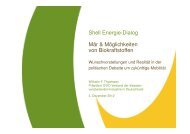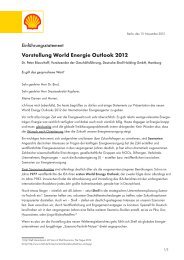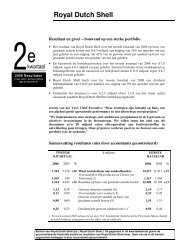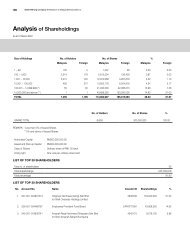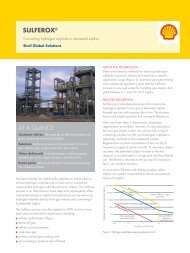ENVIRONMENTAL STATEMENT BARDOLINO DEVELOPMENT
ENVIRONMENTAL STATEMENT BARDOLINO DEVELOPMENT
ENVIRONMENTAL STATEMENT BARDOLINO DEVELOPMENT
You also want an ePaper? Increase the reach of your titles
YUMPU automatically turns print PDFs into web optimized ePapers that Google loves.
Bardolino Development Environmental Statement<br />
Table 6.4: Comparison of the total emissions from the Bardolino development well with<br />
emissions from UKCS well testing and UKCS offshore activities (All values are<br />
thousands of tonnes)<br />
CO2 CO NOx N20 SO2 CH4 VOC<br />
Total emissions from proposed clean-up 7.355 0.038 0.008 0.000 0.000 0.065 0.052<br />
Emissions from UKCS Well Testing<br />
Total emissions from UKCS well testing 1 120.909 0.502 0.10 0.003 0.001 1.401 0.612<br />
Emissions from proposed well cleanup<br />
(as % of UK total)<br />
Emissions from UKCS Offshore Exploration and Production Activities<br />
6.08 7.57 8 0 0 4.64 8.50<br />
Total emissions from UKCS offshore<br />
exploration and production 1 18,333.62 28.57 59.78 1.22 2.94 41.24 48.67<br />
Emissions from proposed well cleanup<br />
(as % of UK total)<br />
0.04 0.13 0.01 0 0 0.16 0.11<br />
Notes: 1. Total emissions for offshore activities includes emissions arising from; diesel, gas and fuel oil<br />
consumption, flaring, venting, direct process emissions, oil loading and fugitive emissions. This includes emissions<br />
from Production and Mobile drilling rigs. The SCOPEC data does not include emissions produced by support vessels<br />
or helicopters. Source: LearnIT, 2006<br />
6.4.2 Impact on sensitive receptors and proposed or designated sites<br />
There are no sensitive receptors or proposed or designated sites that would be impacted by<br />
these emissions. The contribution of these emissions to global processes such as global<br />
warming and acid deposition is discussed in Section 6.4.3.<br />
In the open conditions that prevail offshore, the atmospheric emissions generated during well<br />
clean-up and testing would be readily dispersed. This would ensure that, outside the<br />
immediate vicinity of the flare tip, all released gases would only be present in low<br />
concentrations.<br />
6.4.3 Contribution to transboundary, cumulative or global impacts<br />
As Bardolino is located approximately 40 km from the UK/Norwegian median line, it is<br />
appropriate to consider the potential for trans-boundary transport of atmospheric<br />
contaminants.<br />
Wind conditions experienced offshore in the central North Sea are variable both in strength<br />
and direction, but it is likely that any air emissions at the Bardolino site will be quickly<br />
dispersed. Under these offshore conditions, the small amount of air emissions that would be<br />
produced is unlikely to be sufficient to have any measurable trans-boundary effect. The<br />
short-term, transient nature of the drilling and pipeline installation activities will minimise<br />
power generation emissions to air. The small volumes of resulting exhaust gases are<br />
expected to disperse rapidly in the offshore atmospheric environment.<br />
The potential cumulative effects associated with atmospheric emissions produced by the<br />
drilling operations, pipeline and umbilical activities and well clean-up / testing operations<br />
include global warming (greenhouse gases), acidification (acid rain) and local air pollution.<br />
The temporary increase in emissions from the proposed operations in relation to existing<br />
operations in the area will not result in a significant additive effect when considering the total<br />
annual offshore emission from the UKCS. Table 6.5 indicates that emissions of the identified<br />
pollutants would be equivalent to less than 1% of total annual offshore UKCS oil and gas<br />
atmospheric emissions compared with a 2004 baseline, the latest year for which published<br />
data are available. Table 6.5 also shows that the emission of gases, including carbon dioxide<br />
which contribute to global warming, represent a very small proportion (


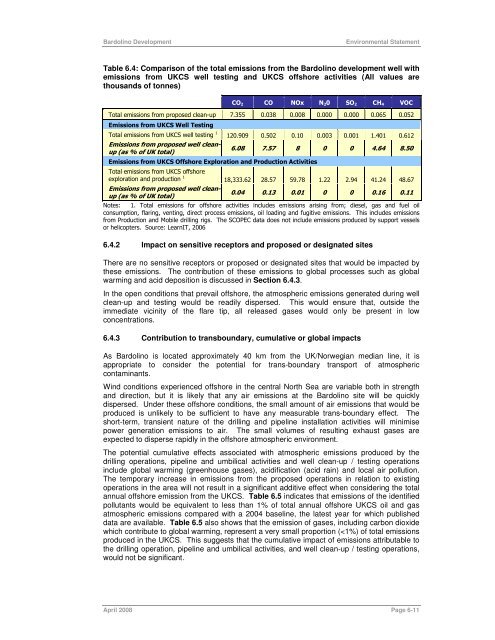

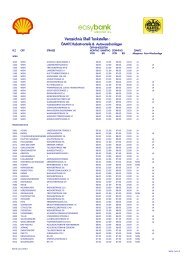
![Download Shell AutoGas Stationen [Stand: Januar 2013] (PDF](https://img.yumpu.com/9982753/1/190x245/download-shell-autogas-stationen-stand-januar-2013-pdf.jpg?quality=85)
